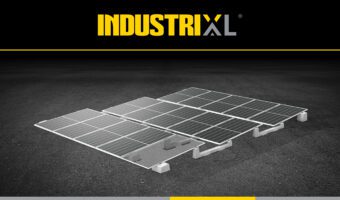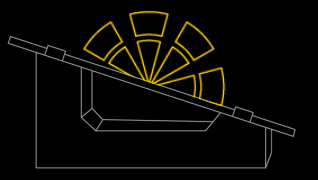Roof loads: how to optimize weights with Sun Ballast photovoltaic ballasts
Managing roof loads is one of the key elements in implementing photovoltaic systems on flat roofs, which is why support systems play a central role, both for building safety and for the reliability and tightness of installations.
How much does a ballast weigh? What parameters should be taken into account at the design stage? For design and installation workers, managing weights requires attention, precision, and professionalism. The weight of structures for photovoltaic installations is a key figure for at least two reasons: first, the safety of the building, and second, the tightness of the installation.
The weight contributed by the anchoring systems must ensure compliance with the load limits of the buildings on which the system is installed, but also ensure that the photovoltaic panels have the highest level of resistance to weathering. That is, the weight of the structures will have to exceed a “minimum weight”-below which wind stresses could cause damage to the system components-without, however, exceeding a “maximum weight,” beyond which the load on the roof could require additional seismic testing or cause serious damage to the building structure. The appropriate plant load should therefore be assessed within this range.
Watchword: modularity
To offer designers and installers a flexible solution to suit any need, it is essential to be able to rely on a range of simple and modular PV panel structures, in which the weight factor can be quickly varied depending on the building type and system requirements. For this reason, the Sun Ballast range of photovoltaic ballasts includes over 40 different models with varying inclinations, weights, and configurations, and offers the possibility not only to select the most suitable mounting system for each specific situation but also to quickly modulate the weight through the use of some simple accessories such as the U-Block supplementary weights (15 and 30Kg) and the special Cablowind concrete channel.
The Advantages of Lattice Systems
First patented almost a decade ago by Sun Ballast, ballasted lattice systems offer photovoltaic systems numerous advantages: in fact, the connection of structures into a single collaborating network makes it possible to achieve an extremely high level of wind resistance, yet without placing an excessive burden on the building’s roof. The force of the wind does not act on the individual panel or structure but is distributed over the entire network of ballasts. In this way, tightness and stability are guaranteed, and lighter ballasts can be used without compromising the safety of the installation in any way. These features have made Sun Ballast’s Connect system one of the most widely used solutions on flat roofs with load limits: the weight per square meter averages less than 20 kg/sqm, and the well-balanced distribution of loads further increases the safety of the installation.
Alongside the Connect system, used by thousands of designers and installers-the Sun Ballast range now includes two other lattice systems: Industrial-XL and EasyWest. Designed to support even the largest panels (even over 2300mm in length) without difficulty, the Industrial-XL system takes the lattice configuration of the Connect system, but offers modules a long-side attachment with portrait arrangement: in this way, it is possible to maximize the performance of the half-cut modules while ensuring their very high wind resistance, reducing the number of ballasts needed for the installation, distributing roof loads in the best possible way, and guaranteeing – as with all Sun Ballast flat roof mounting systems – simple, precise and fast installation.
EasyWest: the next-generation East-West
Developed to meet all the needs of operators in the sector, the new EasyWest system offers not only a solid and durable solution but also an affordable, versatile, and ultra-light one. In fact, the new photovoltaic ballasts can be used with any type of panel, from standard modules to those with lengths greater than 2 meters, in each case respecting all the support parameters indicated on the module data sheets. Like the Connect and Industrial-XL systems, the new EasyWest also provides a lattice configuration: four different panels rest on both the low and the high ballast, and the combination of all the structures into a single interconnected net makes it possible to use lightweight and manageable photovoltaic ballasts. The weight of the EasyWest structures is 28 kg, while the distributed load averages under 20 kg per square meter. The arrangement of the panels in an East-West orientation at 10° also makes it possible to achieve high and constant productivity even on buildings with suboptimal exposures or in geographic areas with a reduced number of daylight hours, and the use of the special PowerClamp clips-as well as offering even stronger and more durable fastening-allow for simple, quick and safe grounding operations.
Comprehensive technical support and load calculations
With more than ten years of experience behind us both in the field of ballasted system development and in the design of PV systems on flat roofs-the goal of Sun Ballast’s technical support is not only to offer support in the use of ballasts but also and above all to guide the customer in selecting the most convenient, safest and most suitable system for his concrete needs. The Sun Ballast Technical Office thus offers all customers and collaborators comprehensive technical support from the earliest design stages, paying special attention precisely to weight management: in fact, Sun Ballast technicians accompany installers and designers in the selection of the best technical-economic solution, first assessing the appropriate load level according to the system requirements, the material present on the roof, the characteristics of the building and the windiness of the area.
Do you want to find out which structure is most suitable for your next flat roof PV system?
Contact the Sun Ballast Technical Office for a free consultation!
https://www.sunballast.com/en/technical-assistance/








